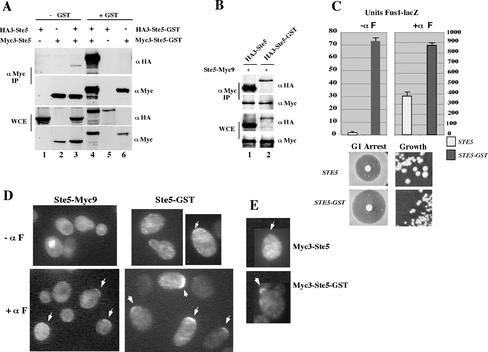Figure 5.
Increasing the pool of Ste5 oligomers by fusing it to GST stimulates Ste5 activity and recruitment to the plasma membrane. (A) Ste5-GST oligomerizes more efficiently. Myc- and HA-tagged derivatives of Ste5 were coimmunoprecipitated from extracts made from EY1775 (ste5Δ) cells coexpressing HA3-Ste5 (pSKM87) with Myc3-Ste5 (pYMW138), and HA3-Ste5-GST (pYMW74) with Myc3-Ste5-GST (pYMW134). (B) Enhanced oligomerization of Ste5-GST requires the presence of GST on both partners. Relative amount of Ste5-Myc9 that coimmunoprecipitates with HA3-Ste5 and HA3-Ste5-GST. (C) Ste5-GST hyperactivates the mating pathway. Quantitation of FUS1-lacZ activity, G1 arrest, and vegetative growth of EY1775 cells expressing Ste5 (pYBS138) and Ste5-GST (pYMW50) from CEN plasmids. For FUS1-lacZ assays, the cells also expressed FUS1-lacZ (pJB207). Strains were induced for 90 min with 50 nM α factor where indicated (+ α factor). (D) Ste5-GST is more readily detected at the plasma membrane than Ste5-Myc9. Indirect immunofluorescence of Ste5-GST and Ste5-Myc9. EY1775 (ste5Δ) cells expressing Ste5-Myc9 (pSKM19) or Ste5-GST (pYMW77) were grown at 30°C with (+αF) or without (-αF) a 15-min exposure to α factor. Ste5-Myc9 was detected with 9E10 antibody and Ste5-GST was detected with anti-GST antisera. (E) Myc3-Ste5-GST is recruited more efficiently than Myc3-Ste5. Indirect immunofluorecence was done on EY1775 (ste5Δ) cells expressing Myc3-Ste5 (pYMW138) or Myc3-Ste5-GST (pYMW134) after 30-min induction with α factor. Both proteins were detected with α-Myc (9E10) antibody.

